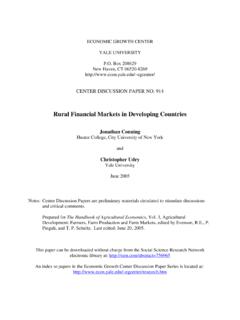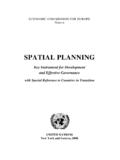Transcription of The New Vision of Local Governance and the …
1 1 The New Vision of LocalGovernance and theEvolving Roles of LocalGovernmentsanwar shah withsana shah1We will strive increasingly to quicken the public sense of public duty; will transmit this city not only not less, but greater, better, andmore beautiful than it was transmitted to us. Oath of office required of council members in the ancient city of AthensIntroduction: Local Government and LocalGovernanceLocal governmentrefers to specific institutions or entities created bynational constitutions (Brazil, Denmark, France, India, Italy, Japan,Sweden), by state constitutions (Australia, the United States), byordinary legislation of a higher level of central government (NewZealand, the United Kingdom, most countries), by provincial orstate legislation (Canada, Pakistan), or by executive order (China)to deliver a range of specified services to a relatively small geo-graphically delineated governanceis a broader conceptand is defined as the formulation and execution of collective actionat the Local level.
2 Thus, it encompasses the direct and indirect rolesof formal institutions of Local government and government hierarchies, aswell as the roles of informal norms, networks, community organizations, andneighborhood associations in pursuing collective action by defining theframework for citizen-citizen and citizen-state interactions, collective deci-sion making, and delivery of Local public Governance , therefore, includes the diverse objectives of vibrant,living, working, and environmentally preserved self-governing communi-ties. Good Local Governance is not just about providing a range of Local ser-vices but also about preserving the life and liberty of residents, creating spacefor democratic participation and civic dialogue, supporting market-led andenvironmentally sustainable Local development, and facilitating outcomesthat enrich the quality of life of the concept of Local Governance is as old as the history ofhumanity, only recently has it entered the broad discourse in the academicand practice literature.
3 Globalization and the information revolution areforcing a reexamination of citizen-state relations and roles and the relation-ships of various orders of government with entities beyond government and thereby an enhanced focus on Local Governance . The concept, however,has yet to be embraced fully by the literature on development economics,because of the longstanding tradition in the development assistance com-munity of focusing on either Local governments or community organizationswhile neglecting the overall institutional environment that facilitates orretards interconnectivity, cooperation, or competition among organizations,groups, norms, and networks that serve public interest at the Local writers (Bailey 1999; Dollery and Wallis 2001; Rhodes 1997;Stoker 1999) have recently argued that the presence of a vast network of enti-ties beyond government that are engaged in Local services delivery or qual-ity of life issues makes it unrealistic to treat Local government as a singleentity (see also Goss 2001).
4 Analytical recognition of this broader concept oflocal Governance is critical to developing a framework for Local governancethat is responsive (doing the right thing delivering services that are con-sistent with citizens preferences or are citizen focused); responsible (doingthe right thing the right way working better but costing less and bench-marking with the best); and accountable (to citizens, through a rights-basedapproach). Such analysis is important because the role of Local governmentin such a setting contrasts sharply with its traditional chapter traces the evolution and analytical underpinnings of localgovernance as background to a better understanding of the case studies ofdeveloping countries in this book. The next section outlines analyticalapproaches to Local Governance that can be helpful in understanding the role2 Anwar Shah with Sana Shahof governments and comparing and contrasting institutional further develops a model of Local Governance that integrates various strandsof this literature.
5 This model has important implications for evaluating andreforming Local Governance in both industrial and developing countries. Thethird section presents stylized models and institutions of Local Governance aspracticed in different parts of the world during past centuries. It comparesand contrasts the ancient Indian and Chinese systems of Local governancewith Nordic, Southern European, North American, and Australian last section provides a comparative overview of Local government organ-ization and finance in selected developing countries as an introduction to thein-depth treatment of these countries in the rest of the Theory: Conceptual Perspectives on Local Governanceand Central- Local RelationsSeveral accepted theories provide a strong rationale for decentralized deci-sion making and a strong role for Local governments, on the grounds ofefficiency, accountability, manageability, and autonomy.
6 Stigler s (1957) identifies two principles of jurisdictionaldesign: The closer a representative government is to the people, the better itworks. People should have the right to vote for the kind and amount of publicservices they principles suggest that decision making should occur at the lowestlevel of government consistent with the goal of allocative efficiency. Thus,the optimal size of jurisdiction varies with specific instances of economiesof scale and benefit-cost spillovers. The principle of fiscal related idea on the design of jurisdictionshas emerged from the public choice literature. Olson (1969) argues that ifa political jurisdiction and benefit area overlap, the free-rider problem isovercome and the marginal benefit equals the marginal cost of production,thereby ensuring optimal provision of public services.
7 Equating the politicaljurisdiction with the benefit area is called the principle of fiscal equivalencyand requires a separate jurisdiction for each public service. The correspondence related concept is proposed by Oates (1972):the jurisdiction that determines the level of provision of each public goodshould include precisely the set of individuals who consume the good. ThisThe New Vision of Local Governance3principle generally requires a large number of overlapping and Eichenberger (1995, 1996, 1999) have extended this idea to definethe concept of functional, overlapping, and competing jurisdictions (FOCJ).They argue that jurisdictions could be organized along functional lines whileoverlapping geographically, and that individuals and communities could befree to choose among competing jurisdictions.
8 Individuals and communi-ties express their preferences directly through initiatives and referenda. Thejurisdictions have authority over their members and the power to raise taxesto fulfill their tasks. The school communities of the Swiss canton of Zurichand special districts in North America follow the FOCJ concept. The decentralization to this theorem, advanced byOates (1972, p. 55), each public service should be provided by the juris-diction having control over the minimum geographic area that wouldinternalize benefits and costs of such provision, because Local governments understand the concerns of Local residents; Local decision making is responsive to the people for whom the servicesare intended, thus encouraging fiscal responsibility and efficiency,especially if financing of services is also decentralized; unnecessary layers of jurisdiction are eliminated; interjurisdictional competition and innovation are ideal decentralized system ensures a level and combination of publicservices consistent with voters preferences while providing incentives forthe efficient provision of such services.
9 Some degree of central control orcompensatory grants may be warranted in the provision of services whenspatial externalities, economies of scale, and administrative and compli-ance costs are taken into consideration. The practical implications of thistheorem, again, require a large number of overlapping jurisdictions. The subsidiarity principle. According to this principle, taxing, spending, andregulatory functions should be exercised by lower levels of governmentunless a convincing case can be made for assigning them to higher levels ofgovernment. This principle evolved from the social teaching of the RomanCatholic Church and was first proposed by Pope Leo XIII in 1891. Subse-quently, Pope Pius XI highlighted the principle of subsidiarity as a third waybetween dictatorship and a laissez-faire approach to Governance .
10 TheMaastricht Treaty adopted it as a guiding principle for the assignment ofresponsibilities among members of the European Union (EU). This prin-ciple is the polar opposite of the residuality principletypically applied in aunitary country, where Local governments are assigned functions that thecentral government is unwilling or thinks it is unable to Shah with Sana ShahImplementation MechanismsAchieving the optimal number and size of Local jurisdictions requires theoperation of community formation processes and the redrawing of juris-dictional boundaries. Voting with to Tiebout (1956), people consider tax costsand the public services menu offered by a jurisdiction in deciding whereto live. Thus, voting with feet leads to the formation of jurisdictions,creating a market analog for public service provision.














